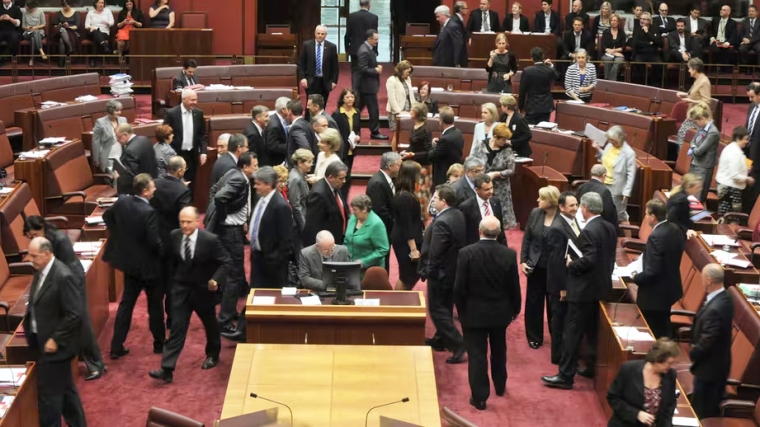
The Australian federal election has finally been and gone. The nation breathes a collective sigh of relief.
As expected, the Labor Party won. It ‘succeeded’ in being the least unpopular of the two major parties. It should be able to form government on its own, just, but the election result is far from a ringing endorsement of the party or its policies.
Labor’s primary vote was less than in 2019 when it lost the previous election. Luckily the primary vote of its opponent, the Coalition (comprising the Liberal and Nationals parties) slumped much more. The big winners were the Greens Party and the so-called ‘teal’ independents.
The message to the two major parties from much of the electorate was clear – a pox on both your houses.
Voting for the Australian House of Representatives is based on a preferential voting system. In the 2007 election, 15% of voters gave their first preference vote to minor parties or independents. By 2019, that figure had increased to 25%. With most of the votes now counted, the figure for the latest election has jumped to 32%.
This trend represents a breaking down of Australia’s traditional two-party system.
The most dramatic demonstration of that was the six blue-ribbon Liberal seats that fell to teal independents. They included Wentworth in Sydney, the wealthiest electorate in the country, and Kooyong, a Liberal stronghold for seventy years, held by the Treasurer.
Teal is a political movement not a party. Its focus is on climate change, political integrity, and gender equality, important issues to wealthy, inner-city voters, particularly women.
Former PM John Howard once described the Liberal Party as a “broad church”. He was referring to the party’s embrace of a wide range of supporters from moderate small ‘l’ liberals through to arch conservatives. In recent years, issues like climate change and same sex marriage have tested the cohesion of Howard’s broad church. The results on Saturday suggest that many in the moderate section of the congregation have had enough. The ideological gap between them and the conservatives has become a chasm that can no longer be bridged.
Moderate Liberal MPs were the big losers on Saturday night, both to teal independents and to Labor. What’s left of the Liberal Party now looks much more conservative than the party that went into the election.
That will almost certainly be reflected in the new leader to replace the outgoing Scott Morrison. The hot favourite is Peter ‘prepare for war’ Dutton, a former policeman and most recently the Minister for Defence. A strong conservative and anti-China hawk, he is very popular with the right wing of his party.
The outcome of voting for the Senate, the upper house in the federal Australian Parliament, has not been finalised. However, it seems clear that the left/progressive side of politics will hold a majority. Good news for the new Prime Minister, Anthony Albanese, as the Senate has an effective veto over legislation passed in the House of Representatives.
What does a Labor government backed by a supportive Senate mean for Australia over the next three years?
More government spending is a certainty. Labor’s own election costings admit that, although the difference is not material over the forward estimates. Of course, Labor will inevitably introduce new spending measures that it did not take to the election. Increased government spending will fuel inflation. Labor spending promises could also make the Reserve Bank raise the cash rate more quickly.
Will Labor increase taxes to pay for its increased spending? Not according to its election promises. Having suffered in the 2019 election when it campaigned on a series of significant tax policies, this year Labor adopted a small target strategy. Jim Chalmers, the new Treasurer, assured voters that there would be no major tax changes under a Labor government.
Increasing expenditure but not revenue would normally mean bigger deficits and more debt. Labor argues that some of its spending will increase productivity and therefore grow the economy and the tax take eg. increased childcare to enable more women to enter the workforce or work longer hours. Time will tell.
Higher wages are another certainty under the new Labor government. When Anthony Albanese was asked during the election campaign if there should be a wage rise to reflect the latest inflation figure of 5.1%, his immediate response was “Absolutely”. His election commitment to help Australians struggling with the rising cost of living, together with his party’s close ties to the union movement, mean that wages will rise faster than they would have under a Coalition government. That will put further upward pressure on inflation.
Of course, despite what politicians told voters during the election campaign, the reality is that there are substantial limits on what the government can do about soaring inflation and rising interest rates. Inflation within Australia’s trading partners, oil price movements, international supply chain delays, the Covid-19 induced slowdown in China, and volatility in international capital markets are beyond the government’s control.
Both issue polling before the election and the electoral success of the Greens and the teal independents indicate that climate change has become a decisive electoral issue. Accordingly, more action on climate change can be expected from Labor. If the Greens hold the balance of power in the Senate, they will demand it. That won’t be without its problems for Labor given the number of its supporters employed in the mining industry.
Immigration is another issue on which Labor will be torn. Many in the party oppose high immigration on the grounds that it suppresses domestic wages and increases congestion in the capital cities; others promote the economic benefits of immigration and favour admitting more skilled labour, more students, and more refugees.
There are numerous other major challenges for the incoming government – the housing affordability crisis, the ongoing pandemic, the fraught relationship with China, the struggling aged care system, water insecurity, the overburdened national disability insurance scheme, geopolitical tensions, and the social and economic gap between indigenous and non-indigenous Australians.
A perfect storm really. You can almost imagine that some in the Coalition will be happy to sit this one out.
Ross Stitt is a freelance writer and tax lawyer with a PhD in political science. He is a New Zealander based in Sydney. His articles are part of our 'Understanding Australia' series.
8 Comments
It ‘succeeded’ in being the least unpopular of the two major parties.
That's how most elections work.
I only hope Prime Minister Albanese fails in his quest to tame inflation and increase wages. The Trans-Tasman gap is already luring too many young Kiwis away. If their government gets traction we could be in serious trouble.
✈️✅
I would say nz is in trouble with our health care workers already targeted and some elderly care residences closing . Labour Australia has made it plain that they are upping the requirements for these and no doubt increasing remuneration will be part of that . The libnats will no doubt move to the right under Dutton and Barnaby (let's mine Antarctica before others do ) Joyce .
Our for-profit Aged Care sector is certainly facing a dire wage shortage.
As a former resident of Australia I have to say I've always preferred NZ's MMP system and a key reason why we moved back to NZ. Having to form coalitions (with in some cases - especially in the last government - quite wide viewpoints) on individual pieces of legislation means we get much better thought through legislation that considers a wide range of voters values and views.
The Australian system does have its check and balance in the senate but bad legislation (religous discrimination bill, lack of action on climate change and the opposition to same sex marriage been cases in point) has been notorious out of both parties over the last 30 years.
The ongoing erosion of the 2 party system will only serve to create better legislation that has the backing of the wider population.
There is however a lesson for NZ out of this- we currently have a Majority government who is using their majority to put through legislation without rigorous debate- whether this results in good or bad outcomes for NZ - the jury is still out on, but I suspect the polls are an indication of Kiwis viewpoint on the process. I seriously doubt that NZ will vote for a majority party again in my lifetime. Democracy only works on democratic grounds - everybody must feel their views and values are considered.
Co-governance is not a democracy. That's the issue.
What? MMP is more democratic than FPP because it allows a wider group to be represented.
If they're kept in the dark and fed b-----it, is democracy capable of facing the issues ahead?
Representation is one thing; intelligent voting for the right thing (and from here on, the choice is existential) is quite another.

We welcome your comments below. If you are not already registered, please register to comment
Remember we welcome robust, respectful and insightful debate. We don't welcome abusive or defamatory comments and will de-register those repeatedly making such comments. Our current comment policy is here.